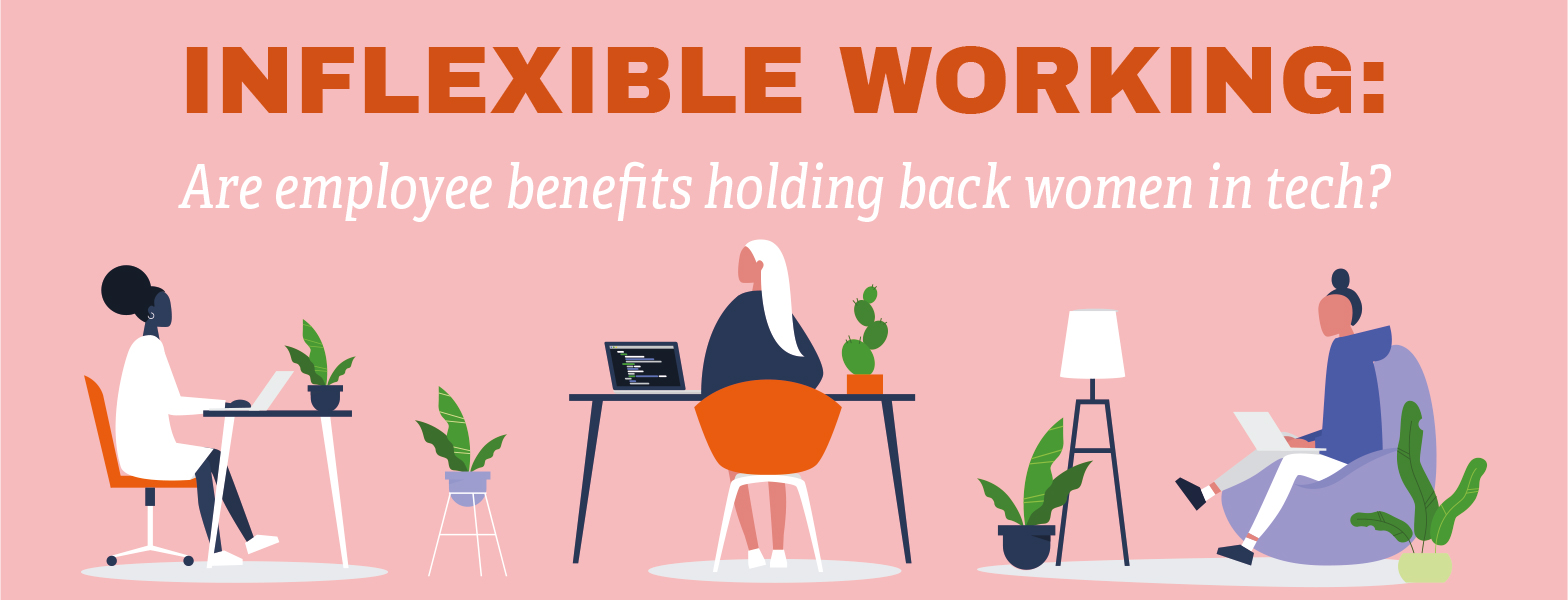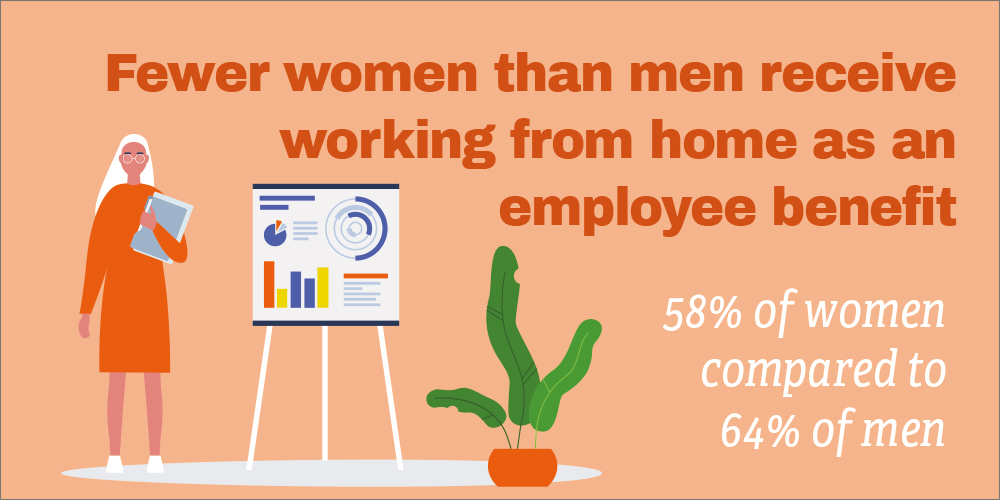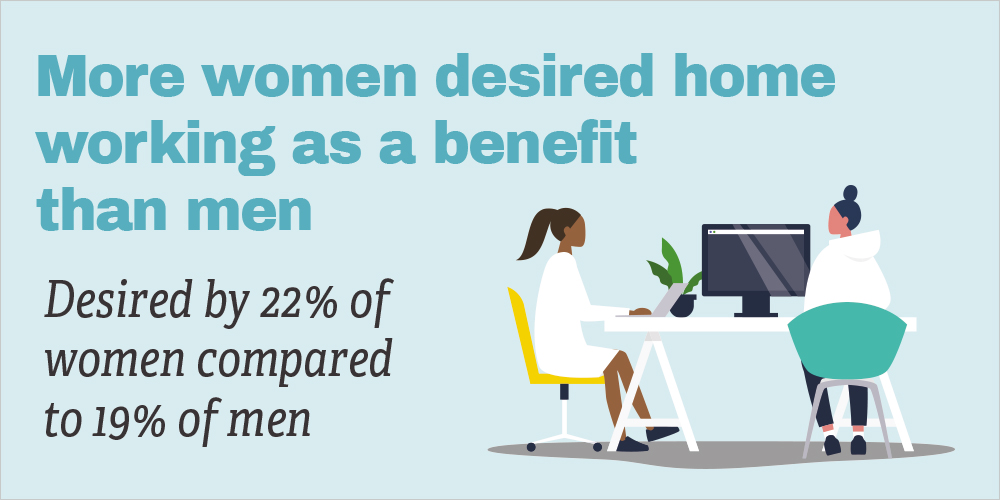
Flexible and home working are the most-desired employment benefits among women in the tech industry, but the stigma attached to these could be having a negative impact on work-life balance and career progression.
This International Women’s Day we’re asking employers to consider whether their benefits carry a gender bias, and whether attitudes towards flexible working are holding back women in tech.


Flexibility stigma: the discrimination and negative perception towards workers who work flexibly, and consequently the negative career outcomes experienced by them.
Exploring the ‘flexibility stigma’:
Despite women making up more than half of the United States workforce, only 20% of tech jobs in the US are held by women.
This translates to some of the larger tech companies, such as Google, where only 23% of tech jobs are held by women, and Twitter where that number is even smaller at 21%.
And while companies have attempted to take action by diversifying their intake, shining a spotlight on women in tech, and addressing gender representation at board level, career progression is still a real challenge for women.
Employers are now being encouraged to also look at the benefits they’re offering staff, and to consider whether they’re providing sufficient support to all different kinds of employees over the course of their careers.


“In nearly every conversation I have with candidates, I’m always asked what the benefits and perks are of working here. I think as the traditional ‘work to live’ attitude declines, candidates are considering other factors beyond salary and comparing the benefits that are on offer with their current package.”
Sarah Dowzell, COO and Co-founder at Natural HR
The benefits gender split


We surveyed over 2,500 tech professionals, of which 30% were female (10% higher than the industry split) and found gender differences in attitude towards desired benefits, as well as a difference in actual entitlement to these benefits.
When asked which benefits they desire most, 22% of female respondents indicated home and flexible working was important to them, compared to only 19% of men. This is significant when compared to actual entitlement, where there’s a great disparity between the genders.
Despite women having a strong desire for home working, only 58% are offered this employment benefit, compared to 64% of men.
There’s an even greater difference when looking at flexible working hours; the benefit is enjoyed by 54% of men, compared to just 42% of women.
Why is this? You could understand a difference in desired employment benefits, as the traditional ‘family-oriented working woman’ may wish to have flexible and home working to fit her schedule, but there’s no rational explanation for a difference in actual entitlement.
While businesses must offer equal pay for equal work, there has to be an acceptance that there are lifestyle differences between the genders, and this will naturally impact both desired benefits and actual benefits taken up by the employee, should they have the option…
“We’ve gotta keep it real and acknowledge there are certain things that impact women and not men. It’s impossible for a male boss, for instance, to understand how much more pleasant working from home might be when you’re dealing with periods or menopause, and very few women would ever bring this topic up.
“In general, women are still primary caregivers, and working around childcare schedules is far easier with flexible working. Interestingly, although the research shows women want more annual leave, studies show that they’re less likely to actually use it all – not wanting to be seen to abandon their duties. Of course, it’s important to acknowledge that woman also want equality, they’re not necessarily asking for special period privileges, they want flexibility for all.”
Amber Coster, founder of Balpro
The flexibility stigma
Employees have been able to make flexible working requests for some years now, and this has been protected as a statutory right in the UK since 2014, but a 2019 poll by the Trades Union Congress revealed that one in three requests for flexible working is turned down.
Our findings suggest women in the workplace may be feeling the brunt of a ‘flexibility stigma’; the idea that they’re contributing less to the business by working flexibly.
Flexibility stigma is the discrimination and negative perception towards workers who work flexibly, and consequently the negative career outcomes experienced by them.
In a 2018 study by Heejung Chung of the University of Kent, 35% of the workers surveyed believed that flexible working created more work for others, while 39% associated negative outcomes with a colleague working flexibly. Perception is bad, but what about actual experience?
“I’ve certainly encountered women who’ve borne the brunt of snide remarks or provocative comments for flexible and remote working. There’s also the stereotype of needing to put in ‘face time’ or go to the pub/socialise with team mates to get ahead. This is of course harder to do when you spend less time at the office, which in turn can lead to being left out of key conversations or not considered as a full member of the team. Unfortunately, this can damage opportunities for promotion.”
Shola Kaye, communication consultant at sholakaye.com
Of those who had worked flexibly in the past, 39% experienced negative consequences as a result of this, and 18% believed it has impacted negatively on their career.
Interestingly, working mothers were by far the largest segment that felt flexible working had negatively impacted their careers (26%), compared to men without children (13%) and working dads (11%).
Some workplaces cultivate a culture of ‘presenteeism’, where being physically in the office is seen as a bragging right or an indication of how hard you’re working. In fact, it’s closer to the opposite. Chung’s study also found that employees with working-time autonomy (such as flexitime) can often work the longest overtime hours to compensate for the perception they aren’t working as hard!
Research from Gallup in its State of the American Workplace report even attributes increased engagement at work to those who spend between three and four days a week working remotely. Interestingly, this group is also the most likely to strongly agree that someone at work ‘cares about them as a person, encourages their development and has talked to them about their progress’.
It’s a tricky spot to be in. Women in the tech industry are looking for flexible working, but there’s a perception they’ll somehow be ‘working less’, and this is having a negative impact on their career progress whether their request is granted or not.
“Some employers worry that without being able to keep an eye on staff in the office, they’ll be slacking off. The reality is very different: most remote workers tend to work harder because they need to show that they are being productive. This does of course live and die on the employer’s willingness to move from measuring time spent at the desk to measuring output and value (…the things that have only ever really mattered).”
Michael Cockburn, CEO at Desana
The implications of not offering these benefits


You have to consider the knock-on effect of not offering these benefits or turning down a flexible working request. A professional who doesn’t enjoy a good work-life balance is more likely to feel isolated and stressed at work, impacting their productivity, performance, and even their motivation.
Women can even feel a greater strain, given they carry out an average of 60% more unpaid work a week than men due to duties outside of work, and can have around 22 hours of childcare on top of that.
Gender certainly comes into play when we look at employees with caring responsibilities outside of work, such as childcare and elder care, with women more likely than men to leave an organization because of caring responsibilities. According to McKinsey & Company’s Women in the Workplace report, 1 in 4 employees who took leave said it hurt their career or finances—this was particularly true for women. Sometimes employees will resign to leaving work to avoid further stress.
Five million people in the UK juggle caring responsibilities with work, and 58% of carers are women. The most-recent ONS stats report that 75% of UK mothers with dependent children are in work, compared with nearly 93% of fathers with dependent children.
“The harsh reality with many employee benefits is that they generally have a very low take-up rate. This is usually because the vast majority of employee benefit packages are off-the-shelf solutions that aim to provide something for everyone but actually provide very little value at all.
“The key is to bespoke employee benefits to the actual needs of the workforce, taking into account the mix of gender, age, race, physical capabilities, business needs and social factors, then look to offer something of real value to everyone, rather than a hundred things of low value to everyone. For example, a 35-year-old single Mum (or Dad!) will benefit far more from flexible working arrangements that allow her to manage childcare around work rather than half-price gym membership.”
Dave Leverton, CEO at Unlimited Wellbeing
It’s important to remember that women who don’t have kids also have legitimate reasons to want to work flexibly, such as a having a mental health issue, an elderly parent, or even simply a difficult commute that makes it challenging to arrive at the same time every day.
These challenges, coupled with the fact that the majority of women in tech are working executive jobs with little scope for decision-making or exercising their skills, make them more vulnerable to burnout in their careers. With burnout being particularly prevalent in the tech industry overall, it means the chances of women in tech suffering this fate are greater.
It offers some explanation as to why the number of part-time self-employed women in the UK doubled between 2001 and 2016, with similar growth for full-time self-employed females. Many women go out on their own for a better work-life balance, but this can lead to financial insecurity and means they no longer have the same employment benefits.
“Employees not having the right benefits can lead to a drop in motivation, stress skyrocketing, and feeling less connected to the workplace. Many people ask for flexible working because working any other way adds pressure to a life that is already feeling too full, often these people are already battling with overwhelm and on the brink of burnout.
“The rejection from this very human request makes people feel less valued and often damages their performance at work as well as their health. For the organisation, put simply, their best talent will leave; one in four UK workers has quit a role for greater flexibility.
“The idea that we all work best between certain hours or in specific environments is archaic. Where one person jumps out of bed with a bright and shiny brain spilling with creative ideas, another doesn’t come to life until they’ve had a couple of hours to adjust. Some people have a dip in the afternoon and find they’re more productive in the evening.
“Companies enforcing specific in-office, working hours drives clock watching, breaks trust and impacts presenteeism. Increasingly, employees are sitting at their desks in body but not mind. It’s not good for employee morale or for business results.”
Amber Coster, founder of Balpro
Whether burnt out from a poor work-life balance and a rejected flexible working request, or demotivated from the negative impact flexible working has had on their career, these attitudes towards flexible and home working could offer an explanation as to why the number of women working in tech jobs is so low.
What’s more, not having access to these benefits can even discourage women from accepting a tech job. When asked which benefits would influence accepting a job offer, 24% of female respondents to our survey indicated flexible working hours were important to them, while 39% would be influenced by home working as a benefit.
Denying access to flexible working not only impacts staff retention and the proportion of women progressing to senior roles, but also initial intake; women would be far more likely to interview for and accept a tech job if there were flexible hours.
“As a woman myself, I do not have kids but I am in a point in my career where I think long-term. When having discussions with other women, this is a common trend. We are no longer thinking about the now, we are beginning to weigh up what our circumstance would be if we decided to start a family.
“Regardless of whether it’s tomorrow or five years down the line, you just never know; life happens! Because of this, some women would rather just have the safety net of knowing they have flexible working, but this can be for other reasons too!”
Bonita Darkoh, diversity and inclusion advocate at bonitadarkoh.com
The solution: change attitudes from the top down
Clearly, barriers to entry are a bad way to go. There’s already an underlying resentment or ill will in the workplace towards those who take flexible hours, so only making this benefit available to women, or parents, is a bad idea. Not everyone needs flexible working in the same way that parents do, but everyone should be entitled to it should they need it.
We need to move away from assessing which benefits an employee is entitled to compared to other employees, and instead focus on optimising their performance at work by leaning on the appropriate benefits. Everybody has a job to do, and they all don’t need to do it while sitting at their desks between 9am and 5pm each week; the important thing is the job gets done on time, done well, and the employee feels good about getting back to work.
Making this benefit available to everyone should reduce this misconception that flexible and home working is just something for parents. But it isn’t enough to offer it; it isn’t a tick-box exercise. You need to make sure your employees are educated on available benefits and then measure the impact these benefits have on performance, so staff know why they exist and why they’re beneficial.
Managers should have a clear line of communication with staff on benefits entitlement and situations where these benefits may be helpful/necessary. There should also be an emphasis on these benefits being there to support professionals, and that employees shouldn’t feel guilty or stigmatised for using them.
“Employers can find it challenging to communicate the value of benefits packages, help employees understand the monetary value of benefits, and encourage uptake of benefits such as life assurance or softer benefits and ‘perks’ such as shopping discounts – even though they contribute significantly to individuals’ reward packages.
“Too often, employees can focus on their salary figure and overlook the value of benefits. Making total reward statements available in your HR system or benefits portal is a key step in helping employees to appreciate the complete value of their reward package.”
Claire Williams, Director of People and Services at CIPHR
There’s plenty of empirical research around improved productivity from flexible working, and employers should also use anecdotal ‘success stories’ from their workplace to outline how flexible working has been utilized in the past. This will also help set parameters around expectations, to reduce the risk of these benefits being abused by employees.
Only by changing the culture of employment benefits by opening them to the whole workforce, and burying obtuse opinions towards flexible working, will women in tech truly feel accommodated and supported across their careers.
Looking to feature or find out more about our research? Contact PR@masonfrank.com


